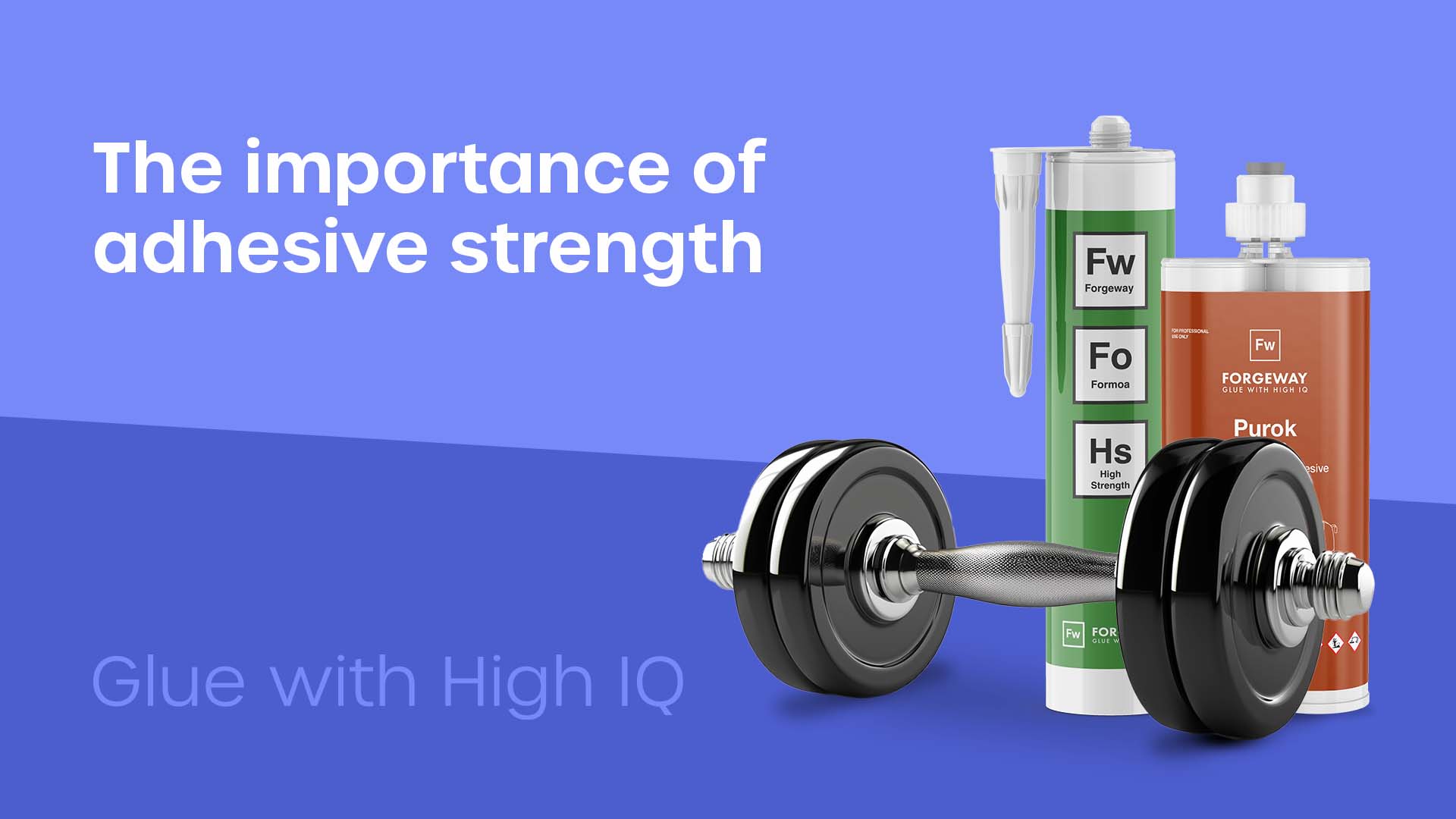The Importance of Adhesive Strength: How to be sure your Adhesive is Strong Enough

When analysing an adhesive solution, strength is one of the main characteristics to focus on. However, most people don’t understand the bigger picture when analysing an adhesive’s strength.
Here at Forgeway, we have been manufacturing industrial adhesives for over 25 years. In that time, we’ve helped our clients understand that strength is more than just a number.
Most people think that the higher the number, the stronger the adhesive will be. Whilst this seems logical, it’s not always the case.
In this article, we will help you understand what ‘strength’ actually means. We will then analyse the importance of a ‘strong’ adhesive and how you can calculate that strength.
What does the ‘strength’ of an adhesive really mean?
There can be a lot of confusing jargon around the term ‘strength’. Some companies will shout out numbers and leave you to assume what those numbers mean.
Other companies will put ‘High-Strength’ all over the packaging to make you believe that it is ‘strong’.
And they’re technically not wrong. Any adhesive could be ‘strong’. Strength is subjective.
However, it’s important to understand adhesive strength so that you can confidently judge whether an adhesive is ‘strong’ or not.
And to do that, you will need to change the way you refer to an adhesive as ‘strong’ and change it to ‘strong enough’.
This is because adhesive strength simply refers to the adhesive’s ability to hold substrates in place.
This ability will depend on two factors:
- How much force it will need to withstand
- The surface area available to bond
For example, you have a heavy metal panel (150kg) that you want to bond onto a metal structure. This means the adhesive will need to withstand a lot of force. However, you only have a small (300mm) total surface area available to bond.
This means you will need a very high-strength adhesive as there is not much surface area available to hold such a heavy material in place.
On the flip side, if you have a lightweight material that has a large surface area available to bond, you will not need such high strength from the adhesive. This is because the adhesive will not need to withstand so much force and has a much wider surface to help spread the load.
Ultimately, the ‘strength’ of an adhesive is subjective. But you should understand it’s not so much about being ‘strong’ as it is about being ‘strong enough’.

Why is strength important in an adhesive?
Stating the obvious, adhesive strength is one of the most important aspects of a successful bond.
In many industrial applications, the adhesive strength of the bonded materials is crucial to the structural integrity of the product.
For example, in the aerospace industry, manufacturers use adhesives to bond aircraft components together. The strength of these bonds is essential for safe operation.
Similarly, in the automotive industry, manufacturers use adhesives in various applications. Bonding body panels and windshield glass are two common applications.
Strong adhesive bonds are essential for ensuring the safety of the end users.
Ultimately, the adhesive strength plays a very important part in ensuring a strong bond. And as we have demonstrated, strong bonds are integral to life safety in certain applications.
However, the adhesive strength isn’t the only factor in ensuring a strong bond. When analysing an adhesive’s performance, companies fixate on strength.
They rarely consider the bigger picture. A strong and durable bond will not be purely down to the adhesive’s strength.
Other factors like flexibility, weathering resistance, and chemical resistance are all factors that will determine how strong a bond will be.
Watch the video below to discover what else you should consider when analysing an adhesive’s performance.
How is adhesive strength measured?
Once again, asking the question about how adhesive strength is measured could give you a range of different answers.
Here at Forgeway, we use a tensometer to measure adhesive strength. There are several methods for measuring the strength of industrial adhesives using a tensometer.
The three most common test methods are overlap shear, tensile, and peel testing.

The tensometer will then give a unit which indicates how much force it took to break the bond.
The unit we use to measure adhesive strength is MegaPascal (MPa). However, other adhesive manufacturers use PSi which is just a different unit of measurement. Converting between MPa and PSI isn’t difficult.
Now you know the method of measuring strength (tensometer) and the unit of measuring strength (MPa or PSI).
But how can you measure the strength of an adhesive? As long as you have the Technical Data Sheet (TDS), it should be simple to find the answer.
Look for the part of the TDS which provides data on either shear, tensile or peel strength testing. Tensile strength is usually the best indicator of overall strength so always look for this where possible.
Once you have found the number and the unit of measurement (MPa or PSI), you can then decide whether that adhesive is strong or not.
To give you an idea, between 0-3 MPa (or 0-400 PSI) would be a low-strength adhesive for bonding lightweight materials.
Between 3-10 MPa (400-1500 PSI) would be a medium-strength adhesive that you could use for semi-structural bonding of heavier materials or a smaller bonding surface area.
When you get above 10 MPa (1500 PSI), you will start to get into the realm of structural adhesives. These adhesives can bond heavier materials with smaller bonding surface areas.
Ultimately, when measuring the strength of an adhesive, you should remember the higher the unit of measurement (MPa or PSI), the higher the strength.

Choosing an adhesive with the right amount of strength
So now you have a greater understanding of adhesive strength, it’s time to work out what ‘enough’ strength looks like for your application.
Here at Forgeway, we manufacture a range of different adhesives with varying strengths. We understand that ‘strong’ is very subjective and will ultimately depend on your application.
You should also be aware that adhesive strength is only one factor that helps ensure a strong and durable bond. Durability will ensure that adhesive strength doesn’t deteriorate over time.
So whilst strength is important, you should remember that a strong bond isn’t just about adhesive strength.
If you want to take a look at how you can find the exact adhesive type for your needs, take our 45-second quiz by clicking the button below.
Or, you can get in touch with an adhesive expert who will help you find the perfect adhesive for your application.
Thomas is the Content Manager here at Forgeway. Thomas' job is to translate the technical jargon from the ivory tower of academia into easy-to-read content that everyone can understand. Forgeway's mission is to answer every question our customers and prospective clients ask, or are apprehensive to ask.
Topics:



